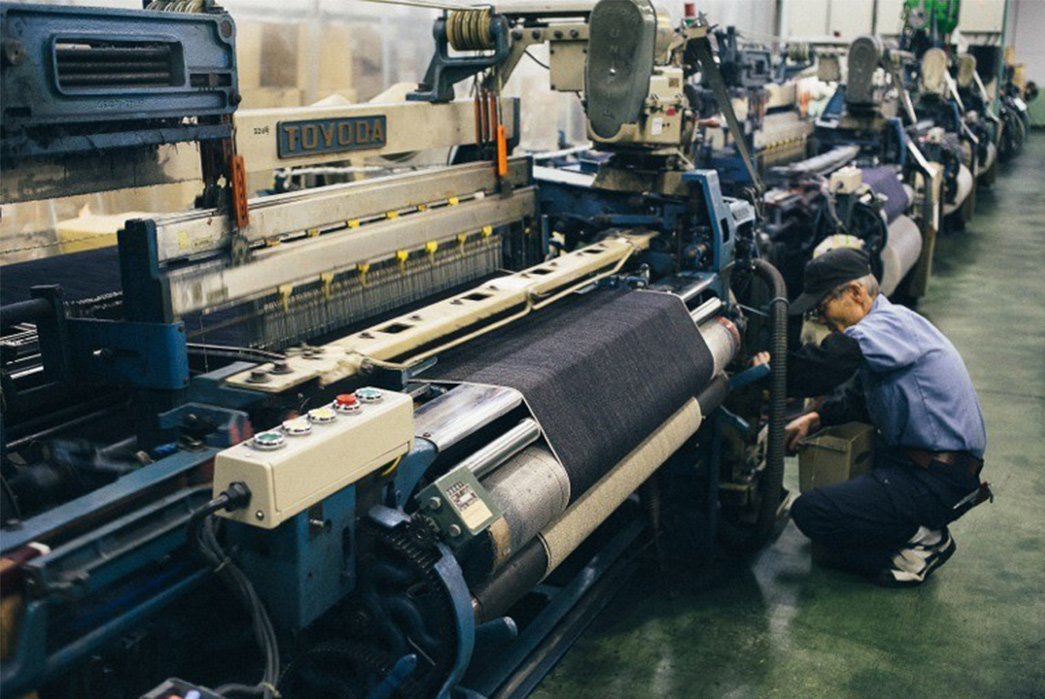Greensboro, North Carolina is a legendary place for any denim fan. Until winter 2017, this was where the weaving looms of the White Oak factory, owned by Cone Mills, were activated. There was produced one of the most famous denim fabrics in the world, which made Levi's famous. Times have changed: White Oak has closed, and Levi's Vintage Clothing, the Californian brand's line of reissues, is now purchasing canvas in Japan. It is no coincidence: purists have long looked to the denim of the Japanese archipelago. Because it is better than its American equivalent? Maybe, but not only.
History is well known: the term denim comes from “sergé de Nîmes”, originally designating a French fabric. Since then, the Americans have made it popular, and most of its production is done in India, Mexico, Turkey, China, and Japan. " There is very good denim canvas in Turkey, India and China, at huge producers ," explains Christopher Bastin, jeans collector and artistic director of Gant, who mainly uses Turkish fabrics. But the Japanese fabric, by its history and the techniques it uses, is more popular. "
In the land of the rising sun, the tradition of indigo is very old. If it was used from the Nara period (710-794), it became popular in the 19th century. The practice remains, and the dye is then reserved for cotton intended for outdoor work clothes, as is also the case in the United States. Jeans are discovered there after the Second World War when the GIs leave theirs behind. They are all the rage among young Japanese people.
In 1967, the first jeans made in Japan appeared, a work by the Big John brand, which used a fabric imported from the United States made by Cone Mills. In 1972, Kurabo produced the first denim fabric produced in Japan. The beginning of a rich story.
The Levi's 501 'Japan Jean' back patch, written in Japanese Levi's
The thicker Japanese fabric, often recognizable by the selvedge (this colored border visible when the jeans are turned over), explodes soon after. It is perfect for extreme washes and, as such, has made the popularity of the French brand APC, which has used it since its beginnings in the 1980s. It has especially led to the fame of manufacturers such as Kurabo, which equips denim the French labels Bonne Gueule and Drapeau Noir, and Kaihara, at the origin of the fabric of the first jeans of the giant Uniqlo and those now used by Levi's.
“ The Japanese's obsession with detail is unmatched: they love American sportswear, they even perfected it. Today, Japanese denim from manufacturers like Momotaro is seen as one of the best in the world , says Christopher Bastin. There are machines there capable of achieving a very narrow weaving that fitted Wrangler, Lee or Levi's. In a way, those who want to make real American jeans today have to go through Japan. Most of the looms used are copies of American looms, the legendary Draper, produced by automobile manufacturers Toyota (under the name of Toyoda), and Nissan.
The 'selvedge', edging, often colored, which we recognize most of the Japanese Heddels
“ The Japanese are excellent copiers. History has different versions, but it seems that they recovered American weaving machines and looms after the war, or that the Americans left them behind to help the country rebuild , suggests Arthur Leclercq, founder of Superstitch , a Parisian workshop specializing in the repair of jeans, which has also just launched its first model of Japanese denim. Nowadays, Japanese denim is seen as a quality label, but it's a bit reductive: there is very good denim made with good threads on beautiful looms in Japan ... and denim made with lower quality yarn, and therefore less good. So why did the Frenchman turn to this country when choosing his own subject? “ The American jeans from White Oak are my reference, but since they are no longer available, I turned to Japanese denim to find what I was looking for. »A softer fabric, with a silky feel, close to that used for the most popular vintage Levi's jeans on the vintage market, like the Big E , recognizable by the red label attached to the right back pocket written in capital letters, out before 1971. Far from what we often imagine when we talk about Japanese denim: a rough, rigid canvas, obtained by adding starch and glue to the thread, popular with purists. “ The selvedge, the origin of jeans, are data popularized by blogs. What distracts the customer more than anything else: when he looks if the jeans are selvedge, he does not look at the quality of the fitting, or the touch. Yet it is by its grain and its outfit that one recognizes a good canvas, ”regrets Arthur Leclercq.
James Dean in jeans on the Japanese poster of "The Fury of Living" Warner Bros.
Levi's, for its part, decided: since the stocks of White Oak denim are exhausted, all the jeans in its Vintage Clothing line will now be made of Japanese denim. " We have been using Japanese fabrics for 10 years for some models, and we thought directly of Kaihara when we had to recreate our historic fabrics ," explains Paul O'Neill, creative director of Levi's Vintage Clothing. The attention to detail and the level of know-how of the Japanese were essential to recreate our 'shrink-to-fit' fabrics as well as possible. These canvases which shrink in the wash to match the shapes of the one wearing the jeans and which made the 501 cult in the 1940s and 1950s.

